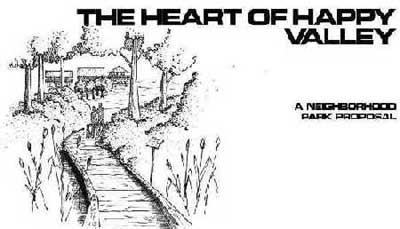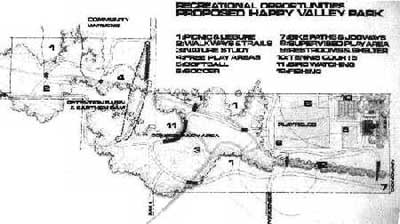I hatched the idea for this park from neighborhood concerns around flooding,
drainage and development. I did a policy analysis of expenditures planned
for funds earmarked in the area and found substantial reason to revisit
the decisions. Of course, government doesn't usually alter course just
because of a few good reasons. Government does respond. It just takes
time. Eight years elapsed between the initial proposal and the completion
of land acquisition. Needless to say, a certain measure of sustained
community organization was required to see it through. Today the 23
acre Connelly Creek Nature Area is a significant hub in a citywide system
of trails. It functions as a laboratory for local schools and is recognized
as an example of integrated habitat preservation, storm water management
and park planning.
The following is the introduction and a few selected graphics from the
original twenty five page analysis and proposal.
(Note: This document was originally written on a typewriter! The drawings
were labeled with pressure transfer letters. Image quality reflects
the Scan/OCR conversion to digital files. Images are a little slow loading,
but couldn't be reduced further without serious compromise. The print
fared better)
INTRODUCTION:

Drainage was established as a top priority for the neighborhood during
the 1981 Community Development Block Grant Planning Program. Its need
is undeniable. Virtually every yard in Happy Valley experiences some
ponding during rainy periods. Water stands for days in ditches and depressions.
The general inconvenience and the land use limitations imposed by poor
drainage are clearly unacceptable.
However, our individual drainage problems cannot be met until the capacity
of Padden Creek is increased. The present flood hazard caused by downstream
constrictions in Padden Creek would be increased by attending first
to lot-specific drainage problems. Essentially, expanding the flow capacity
of Padden Creek is the first logical step in improving drainage in Happy
Valley.
Therefore, the Happy Valley Neighborhood has budgeted $250,000 of its
1981 Community Block Grant funds toward solving this greater drainage
problem. This money will be used to build an open drainage channel for
Padden Creek to bypass an insufficiently sized culvert currently in
use under Valley Parkway. Through other funds, the city has additionally
targeted approximately $200,000 in 1981 to build a massive earthen dam
on Connelly Creek. The dam is intended to retain peak storm drainage
flows and will reduce the demand on the downstream channel. Padden Creek,
between 24th and 30th streets, is also undergoing improvements to increase
its channel capacity. This is part of a development contract between
the city and Ring Sievers & Skeers Construction. The net result
of these and other proposed improvements will be a functional and reliable
drainage system which will safely carry our present and anticipated
storm drainage volumes. This will eliminate the risk of flooding.
Unfortunately, this will also put the neighborhood at a disadvantage
with respect to fulfilling our recreational needs and goals. Much of
Happy Valley's open space has remained undeveloped largely because of
the inadequacy of the drainage system in the valley. Ironically, the
drainage problems have been the neighborhood's only real grip on the
valley's remaining openspace. A predictable drainage system - engineered
for the anticipated runoff volumes of the valley's zoned densities -
will also eliminate the neighborhood's last legitimate complaint against
development.
Land values will increase as developers begin to take hold of the opportunity
to build on parcels of land which have never been platted into single
family lots. Meanwhile, to meet our local drainage needs, we will have
to invest additional funds to improve our ditches and culverts. This
most logically will be accomplished at the same time as street improvements
are made. These, too, will require additional funds. With drainage established
as the top neighborhood priority, we may find ourselves locked into
a funding sequence of street and drainage improvements while recreational
opportunities diminish and land values rise. Improving drainage and
streets will drive up land prices in the valley. Additional development
will occur. These two conditions reduce the neighborhood's ability to
fulfill its recreational needs. Land will become too expensive or otherwise
unavailable.

Thus, if land acquisitions for recreational facilities are not made
now - while community development funds are available and before drainage
improvements are completed - we may never be able to afford to meet
the high priority of community recreation areas. Two factors help to
clarify the situation. On the one hand, if drainage improvements are
delayed their cost will increase only relative to inflation. On the
other hand, openspace costs will soar if delayed until after drainage
improvements are completed. The tremendous increase in cost will be
a direct result of our expenditures.
It is by virtue of its remaining openspace that Happy Valley has such
an unusual potential for growth. At the current time, more than half
of the neighborhood remains undeveloped. Local zoning policies encourage
multiple and cluster developments through a program of density bonuses.
The population of the valley could more than double before development
is complete. The low-to-moderate income people targetted by this kind
of housing will also generate a tremendous recreational need. Presently,
apart from the already overtaxed schoolyards, there are no recreational
facilities in Happy Valley. Since the neighborhood will most likely
experience a significant leap in population, the question becomes: How
will these people be able to meet their recreational needs, and how
will we meet our neighborhood goals. By acquiring land for recreational
uses now, facilities can be developed later as funds allow and needs
indicate. By failing to acquire land now, the increase in cost for future
land purchases will cause facility development to lag even further behind
the growing neighborhood need.
More important than the economics involved in this situation is the
extraordinary occasion we have to make a significant and lasting improvement
in the Happy Valley area. By foreseeing our potential for growth and
the possible pitfalls of our currently planned sequence of neighborhood
improvements, we can take advantage of a unique opportunity to meet
our growing recreational need as well as a whole variety of neighborhood
and city-wide goals . By reassessing our neighborhood needs and reestablishing
recreation and openspace as our top priority, we can provide for the
development of a neighborhood network of pedestrian trails and bicycle
paths. We can fit this network neatly into a city-wide system of openspace,
recreation, and pedestrian facilities. We can also preserve the outstanding
wildlife habitat and environmental features of Happy Valley as valuable
educational resources for our neighborhood schools. Above all, by laying
the groundwork for these improvements now, we can insure that our developmental
policies will lead us toward the kind of functional and aesthetic community
we all desire.

